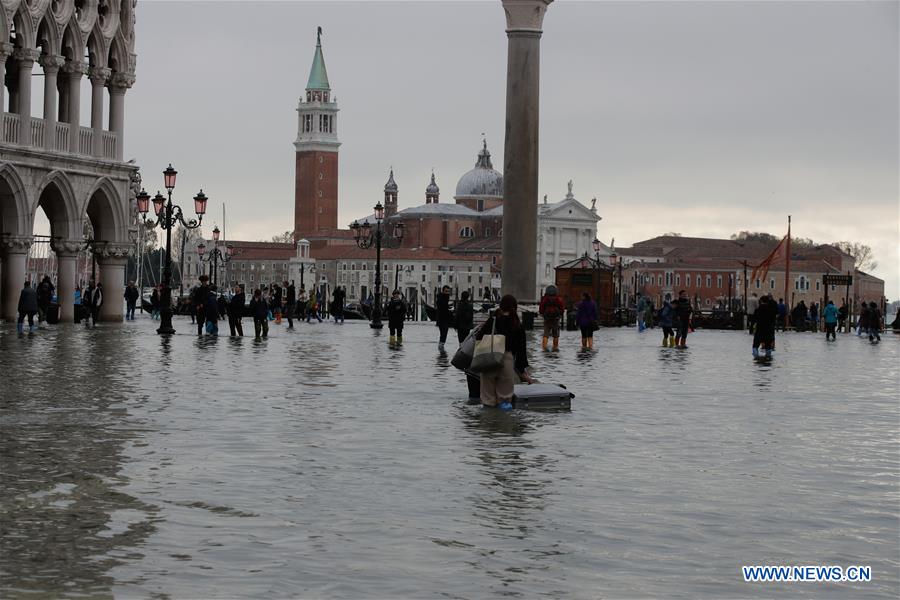
People walk across the flooded San Marco Square in Venice, Italy, Nov. 13, 2019. Residents of the flooded city of Venice are calling for an ambitious flood protection plan, first drawn up decades ago, to be completed, despite worries from environmental groups that the plan could cause ecological damage to the surrounding area. Floodwaters in the northern Italian city this week have reached as high as 187 centimeters, the highest level since the historic flood of 1966. (Photo by Alberto Lingria/Xinhua)
ROME, Nov. 13 (Xinhua) -- Residents of the flooded city of Venice are calling for an ambitious flood protection plan, first drawn up decades ago, to be completed, despite worries from environmental groups that the plan could cause ecological damage to the surrounding area.
Floodwaters in the northern Italian city this week have reached as high as 187 centimeters, the highest level since the historic flood of 1966.
Venice Mayor Luigi Brugnaro said "Venice is on its knees" in an interview, adding that the floods have damaged and sometimes destroyed priceless cultural and historical riches and crippled the city's economy.
Severe flooding is hitting Venice and other coastal cities more frequently and with more force than ever before. When Brugnaro was asked what should be done to protect the city he oversees, he stated: "I think it is time for MOSE to work."
MOSE -- the name is shorthand for Experimental Electromechanical Module -- is an in-progress, integrated system of submerged gates that can be raised to the surface at three key junctures leading to the Venice lagoon.
It is the centerpiece of a plan that, when completed, should be able to protect the city from floodwaters as high as 300 centimeters, nearly twice as high as those seen in the latest floods.
According to Giuseppe Passoni, a professor of environmental and land planning at the Polytechnica University of Milan, plans that led to the MOSE initiative were first drawn up in the wake of the 1966 flood, which saw water levels reach a record 194 centimeters.
The specific plan was first drawn up in 1987 and construction work on the project began in 2003. The plan was originally scheduled to be completed last year but due to delays, it is now expected to be operational in time for the winter of 2022. The final price tag for MOSE, once completed, is estimated to be around 7 billion euros (7.7 billion U.S. dollars), Passoni said.
"There is no other alternative for protecting Venice," Passoni told Xinhua.
"There are other ideas but they are much more expensive and must riskier and it is less clear they will work. Nobody thinks Venice should be abandoned, and this is the only plan capable of keeping the city safe."
But the plan still has many critics, particularly in the environmental community.
When the gates rise to protect the Venice lagoon from floodwaters, they prevent the waters of the ecologically delicate lagoon from being oxygenated. If that happens too often, it would put fish and bird species that live in the lagoon at risk, according to Luigi D'Alpaos, a hydrologist from the University of Padova.
If the gates are raised every time water levels reach 50 centimeters, as planned, the gates could be raised for around half of each year, according to estimates from the Intergovernmental Panel on Climate Change. With that frequency, most wildlife in the Venice lagoon would disappear.
"To save the lagoon, the city would have to open the gates and then the city would flood," D'Alpaos said.
Some environmental groups led by Consorzio Venezia Nuova, which is made up of national and local construction companies, said the gates could be used only on days when floodwaters reached 110 centimeters, a level that would allow the lagoon to remain oxygenated but would leave at least 12 percent of the city underwater every time water levels rise.